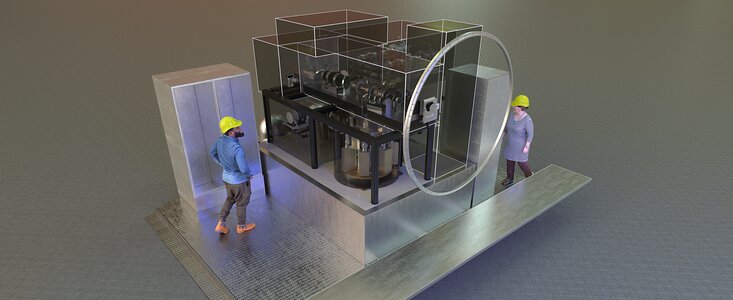Australian Involvement with the European Southern Observatory

This computer model shows what the future VLT instrument MAVIS, being developed by a consortium led by the Australian National University, will look like. The boxes indicate the various submodules of the instrument. Credit: ESO/MAVIS consortium/L. Calçada
Australia became a Strategic Partner of the European Southern Observatory (ESO) on 11 July 2017, further strengthening ESO’s programme and giving Australian astronomers and industry access to the La Silla Paranal Observatory. The partnership was strengthened with a revised agreement signed on 9 February 2022, allowing Australia to join ESO’s Technology Development Programme. The partnership does not include access to ALMA or to ESO’s Extremely Large Telescope.
Because Australia is an ESO Strategic Partner, it has observers in various ESO governing and advisory bodies; the current observers from Australia attending ESO Council meetings and many of the ESO committee meetings can be found here.
Here follows some information about Australia's involvement with ESO.
Discoveries by Australia-based astronomers using ESO telescopes
Australian researchers and those based at Australian institutions have been involved in important discoveries using ESO facilities. These include
- Using the MUSE instrument on ESO’s Very Large Telescope (VLT), the closest supermassive black hole pair was discovered by a team of astronomers, including Holger Baumgardt of the University of Queensland.
- Rebecca McElroy, at the time a PhD student at the University of Sydney, who led a study that resolved the mystery of a rare change in the behaviour of a supermassive black hole at the centre of the distant galaxy Markarian 1018.
Australian involvement in ESO instruments and telescopes at ESO sites
Australia will contribute to many aspects of ESO, including the technology behind advanced instruments, ESO telescopes and telescopes based at ESO sites. So far, Australian institutes have been involved in
- An Australian–European consortium, led by the Australian Astronomical Optics (AAO), which is behind MAVIS, a future instrument on ESO’s VLT. MAVIS is being designed by two Australian institutes in the AAO consortium — the Australian National University and Macquarie University. MAVIS will provide images up to three times sharper than the Hubble Space Telescope and tackle questions such as how the first stars formed 13 billion years ago and how weather changes on the planets and moons of the Solar System.
- The development of the FLAMES spectrograph at the VLT. The Australian National University and the Anglo-Australian Observatory were part of the consortium responsible.
- The 4MOST spectrograph, currently being developed by a consortium including Australia, which will sit at ESO’s VISTA telescope based at the Paranal Observatory.
Australian industry and technology contributions to ESO
The strategic partnership has been opening up opportunities for Australian scientists and industry to collaborate with ESO Member State institutions on ESO instruments since 2017. However, Australian companies and institutions have only been eligible to work with ESO in developing future technologies for ground-based telescopes since early 2022. In the coming years, Australian companies and institutes will be eligible for certain ESO contracts. Australia will have the opportunity to gain access to more significant research and industry contracts if it becomes an ESO Member State in the future.